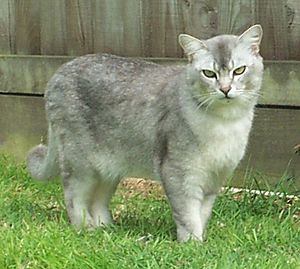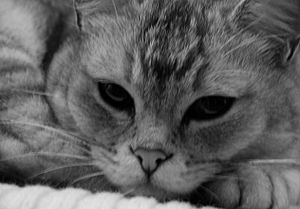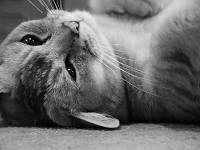Burmilla facts for kids
Quick facts for kids Burmilla |
|
|---|---|

A "blue" male Burmilla
|
|
| Other names | none |
| Origin | |
| Breed standards | |
| CFA | standard |
| FIFe | standard |
| ACF | standard |
| CCA-AFC | standard |
| Domestic cat (Felis catus) | |
The Burmilla is a special kind of domestic cat that first appeared in the United Kingdom in 1981. This breed is a mix between two other cat breeds: the Chinchilla Persian and the Burmese cat. Soon after they were discovered, rules for what a Burmilla should look like were created in 1984. By the 1990s, the breed became officially recognized in the UK, meaning they could compete in cat shows.
Contents
How the Burmilla Cat Breed Began
The Burmilla cat breed has a fun origin story! It all started in the United Kingdom. There were two cats, a Chinchilla Persian named Sanquist and a Brown Tortie Burmese named Fabergé. They were both waiting in different rooms for a partner of their own breed.
One night, a cleaner accidentally left the door open between their rooms. Sanquist and Fabergé met and, well, they fell in love! In 1981, they had four kittens together. These kittens were the very first Burmillas, and that's how this new cat breed was born.
What Does a Burmilla Look Like?
Burmillas are known for their beautiful looks. They are medium-sized cats with strong, yet graceful, bodies. They usually weigh between 3 and 6 kilograms (about 6.5 to 13 pounds). Their most special features are their shiny silver fur and the unique "makeup" lines around their nose, lips, and eyes.
Body Shape and Size
Burmillas have a strong and elegant body. They are not too big and not too small. Their muscles make them look athletic, but they still have a graceful shape.
Head and Face Features
Their head is gently rounded on top. It's wide between their ears and at their jaw, then it narrows down to a short, blunt nose area. If you look at their profile, their nose has a gentle dip. Their chin is firm and lines up nicely with the tip of their nose.
Ears and Eyes
Burmilla ears are medium to large. They are wide at the bottom and have slightly rounded tips. They tilt a little bit forward. Their eyes are big and set far apart, giving them a slightly slanted look. The top line of their eye angles towards the nose, while the bottom line is more curved. Their eye color is usually a bright green. Sometimes, kittens and young adults might have a bit of gold or yellow in their eyes, which is normal.
Burmilla Cat Coat Types
The Burmilla comes in two main fur lengths: short hair and semi-long hair.
- Shorthair Burmilla: This is the most common type. Their fur is short and lies close to their body, similar to a Burmese cat. It feels very soft and silky because of a special undercoat.
- Semi-longhair Burmilla: These cats are sometimes called Tiffanies in some cat clubs. They have longer fur that follows the shape of their body. It's also very soft and silky, and they have a big, fluffy tail.
The short hair gene is stronger (dominant) than the long hair gene. This means if a cat gets one of each gene, it will have short hair. However, if two semi-longhair Burmillas have kittens, all their kittens will have semi-long hair.
Amazing Coat Colors
Burmillas come in many beautiful colors! These include black, blue, brown, chocolate, and lilac. You can also find red, cream, and tortoiseshell (calico) colors, though these are not yet recognized by all cat clubs.
The Burmilla's fur also has different patterns of shading:
- Tipped: These Burmillas have just a light dusting of color on the very tips of their fur (about 1/8 to 1/4 of the hair). If they are silver, they can look almost white!
- Shaded: These cats have more color, covering about 1/4 to 1/2 of each hair. This makes it look like they have a "mantle" of color over their back, shoulders, and legs.
Their nose leather (the skin on their nose) matches their fur color and is outlined with the same shading color. Their paw pads also match their fur:
- Black Silver cats have black or very dark brown paw pads.
- Brown cats have dark brown paw pads.
- Chocolate cats have pinkish-brown paw pads.
- Blue cats have blue-grey paw pads.
- Lilac cats have dove grey paw pads with a hint of pink.
Burmilla Cat Personality
Burmilla cats are known for being quite playful and independent. They really love their owners and often act like kittens, even when they are grown up! They are very friendly, enjoy playing, and are affectionate. They usually get along well with children and other pets.
To keep a Burmilla healthy, it's good to feed them a balanced diet of raw meat, canned food, or dry food. It's also a good idea to brush their fur once a week to keep it soft and tidy.
See also
 In Spanish: Burmilla para niños
In Spanish: Burmilla para niños




